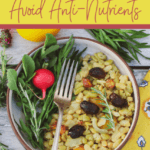How to Prepare Dried Beans to Avoid Anti-Nutrients

People have grown very concerned over anti-nutrients in beans, which may reduce the availability of essential vitamins and minerals in these foods. But is this something you should worry about? Today, I’m answering your top nutrition questions on how you can prepare dried beans to avoid anti-nutrients.
How to Prepare Dried Beans to Avoid Anti-Nutrients
Question:
How should I prepare dried beans to avoid anti-nutrients?
Answer:
A lot of recent hype has surrounded the anti-nutrient compounds found in beans and other whole plant foods. Some websites and fad diets even list these plant foods as “toxic”, suggesting that you avoid all legumes (beans, lentils, peas). However, a body of research has linked beans with multiple health benefits, including reduced risks of heart disease, type 2 diabetes, obesity, and certain types of cancer. So, instead of avoiding them, let’s learn a bit more about legumes and their anti-nutrients.
Dried beans and peas contain anti-nutrients, which are naturally-occurring plant compounds (i.e., phytates) that can limit the body’s absorption of nutrients from these foods. Soaking beans overnight, discarding the water, then cooking them in fresh water can help reduce the amount of anti-nutrient compounds. As an added benefit, it can reduce the complex sugars in beans that are linked with gas and bloating.
So how long should you soak beans? A review of 33 studies that tested the effect of soaking beans or chickpeas found the greatest and most consistent decreases in phytate levels occurred when the beans or chickpeas were soaked for 12 hours in distilled water at room temperature, but studies that used tap water showed similar results. This process reduced phytate levels by up to 66%. Adding an acid (such as lemon juice) did not show an additional benefit.
Most studies show that soaking beans for a moderate amount of time, such as 12 hours, increases their overall nutritional value. Soaking legumes for longer than this may result in a greater loss of nutrients. After soaking, if you drain the water and use new water to cook the beans it can further reduce anti-nutrient levels, according to research. And germinating (sprouting) beans further reduces anti-nutrient levels, according to research.
One study shows that canned beans have lower phytate levels than dried, un-soaked beans, indicating that the canning process (which may include soaking, or blanching or pressure cooking at high heat for a short period of time, depending on which process is used) is also effective in reducing anti-nutrients. Phytate levels in canned beans were reduced by 92% in black-eyed beans, 70% in red kidney beans, 68% in mung beans, and 75% in pink beans in the study.
The bottom line: Don’t ditch the beans. Just soak and cook them properly. That’s what humans—who have relied upon legumes as a core part of traditional diets—have been doing for centuries.
Check out the other nutrition questions I’m answering at The Plant-Powered Dietitian:
Does Roasting Veggies Ruin Nutrients?
Is “Clean Eating” a Healthy Lifestyle?
What are the Different Types of Vegetarian Diets?
For some of Sharon’s favorite bean recipes, check out:
Mediterranean Persimmon White Bean Kale Salad
Chipotle Black Bean Quinoa Veggie-Burgers
Penne with White Beans and Greens
Southwest Stuffed Bell Peppers with Black Beans and Quinoa
About Ask Sharon:
As part of my program “Ask Sharon”, I am answering the top question of the month submitted through my blog, Facebook, Twitter or Instagram to answer here. You can even win a prize! Don’t forget to submit your burning nutrition question this month via my blog, or other social media.
Image: Heirloom Bean Cassoulet with Root Vegetables, Sharon Palmer, MSFS, RDN






[…] and wellness folks that beans may have some negative nutritional effects (beyond gas). Nutritionist Sharon Palmer discusses and debunks this recently popularized issue. In fact, she notes that canned beans have […]